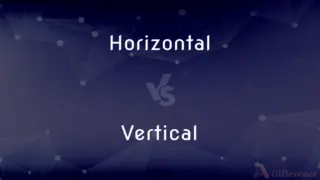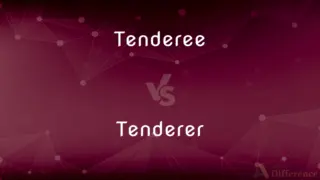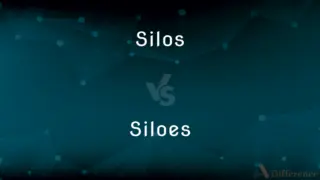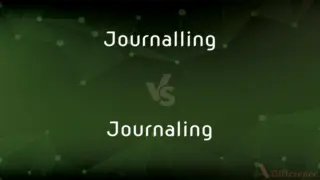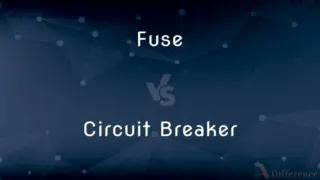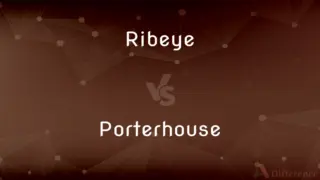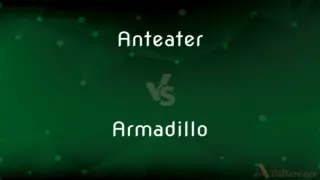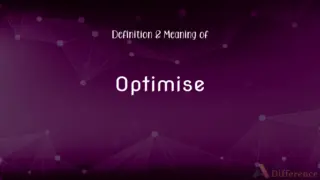Half Duplex Transmission Mode vs. Full Duplex Transmission Mode — What's the Difference?
By Tayyaba Rehman & Urooj Arif — Published on January 30, 2024
Half Duplex Transmission Mode allows two-way communication, but not simultaneously. Full Duplex allows simultaneous two-way communication.
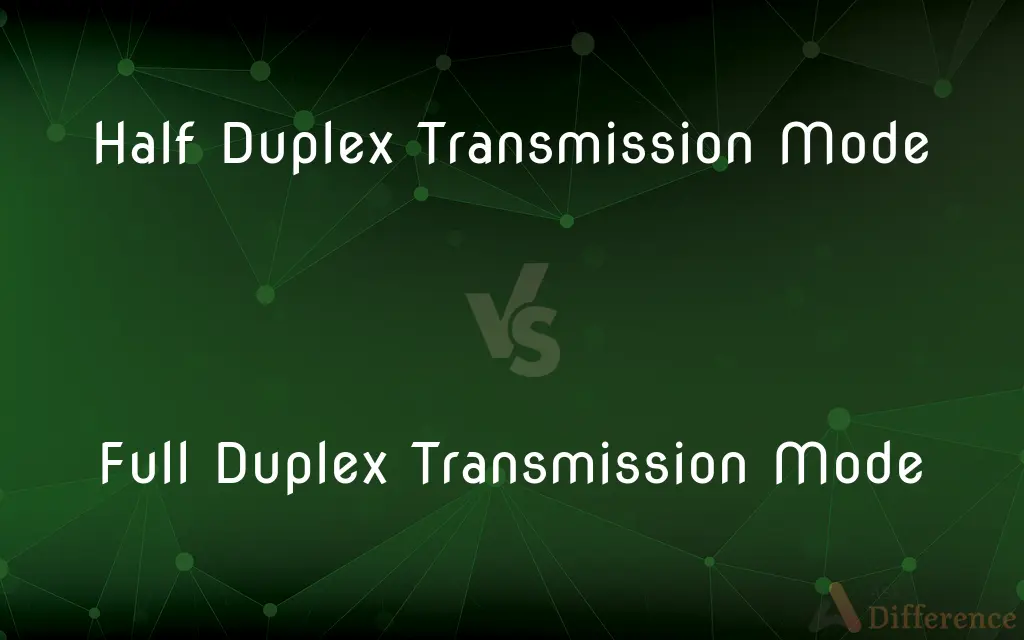
Difference Between Half Duplex Transmission Mode and Full Duplex Transmission Mode
Table of Contents
ADVERTISEMENT
Key Differences
Half Duplex Transmission Mode is a communication method where data can be transmitted in both directions, but not simultaneously. In contrast, Full Duplex Transmission Mode allows simultaneous two-way communication, enhancing speed and efficiency.
In Half Duplex Transmission Mode, a device must wait for the other to finish transmitting before it can send data. Full Duplex Transmission Mode, however, enables both devices to send and receive data at the same time without waiting.
Half Duplex Transmission Mode is like a two-way street where only one vehicle can pass at a time, leading to potential delays. Full Duplex Transmission Mode is akin to a dual carriageway, allowing traffic to flow in both directions simultaneously.
Half Duplex systems are simpler and less expensive but less efficient than Full Duplex systems, which require more complex and costly hardware but offer greater efficiency and speed.
In practice, Half Duplex Transmission Mode is suited for environments where simultaneous communication is not critical, whereas Full Duplex is ideal for high-speed, real-time communication needs.
ADVERTISEMENT
Comparison Chart
Communication Direction
Two-way, but not simultaneous
Simultaneous two-way
Efficiency
Less efficient due to wait times
More efficient with no wait times
Example
Walkie-talkies
Telephone conversation
Hardware Complexity
Simpler, less expensive
More complex, costly
Use Case
Suitable for non-critical, sequential communication
Ideal for high-speed, real-time communication
Compare with Definitions
Half Duplex Transmission Mode
A communication mode where data transmission occurs in both directions, but not at the same time.
Walkie-talkies use half duplex transmission mode, requiring users to take turns speaking.
Full Duplex Transmission Mode
Full Duplex Transmission Mode is akin to a two-lane road with traffic flowing in both directions at once.
Using full duplex mode, the data center achieved higher throughput and real-time data exchange.
Half Duplex Transmission Mode
This mode enables bidirectional communication, but requires switching between transmitting and receiving.
The half duplex setting on their radio system meant the team had to coordinate their communication carefully.
Full Duplex Transmission Mode
Full Duplex allows two-way communication to occur at the same time in both directions.
Modern ethernet connections use full duplex mode for efficient and simultaneous data transfer.
Half Duplex Transmission Mode
Half Duplex allows two-way communication with a flip-flop between sending and receiving.
In half duplex mode, the network card can either send or receive data, but not both at once.
Full Duplex Transmission Mode
A system that supports simultaneous sending and receiving of data between two devices.
The full duplex feature in the conference call system enabled seamless two-way discussion.
Half Duplex Transmission Mode
A system where communication can occur in both directions, but only one party can transmit at a time.
The half duplex system in the security intercom prevented both the guard and visitor from talking simultaneously.
Full Duplex Transmission Mode
This mode provides a continuous, simultaneous two-way communication channel.
The full duplex setting on their wireless network allowed for uninterrupted streaming and uploading.
Half Duplex Transmission Mode
Half Duplex Transmission Mode is a two-way communication method, with a time-sharing protocol for each direction.
Older modems used half duplex mode, alternating between sending and receiving data.
Full Duplex Transmission Mode
A mode of communication where data can be sent and received simultaneously.
Full duplex transmission mode allows for a conversation on the phone without interruption.
Common Curiosities
What is Full Duplex Transmission Mode?
Full Duplex Transmission Mode is a communication method where data can be sent and received simultaneously.
Can Half Duplex Mode handle high-speed communications efficiently?
Half Duplex Mode is less efficient for high-speed communications due to its alternating data transmission method.
How do devices communicate in Half Duplex Mode?
In Half Duplex Mode, devices communicate by alternately sending and receiving data, not simultaneously.
What is Half Duplex Transmission Mode?
Half Duplex Transmission Mode is a communication method where data can be sent and received, but not at the same time.
Is Full Duplex Mode suitable for high-speed internet connections?
Yes, Full Duplex Mode is ideal for high-speed internet connections due to its simultaneous data transmission capability.
How do devices communicate in Full Duplex Mode?
In Full Duplex Mode, devices can send and receive data at the same time without any delay.
What are common uses of Half Duplex Transmission Mode?
Common uses include walkie-talkies, CB radios, and older networking systems.
Is Full Duplex always better than Half Duplex?
Full Duplex is generally better for continuous, high-speed communication, but Half Duplex can be sufficient for less demanding applications.
What are common uses of Full Duplex Transmission Mode?
Common uses include telephone systems, modern networking, and live streaming applications.
Do Half Duplex systems require special hardware?
Half Duplex systems typically require simpler and less expensive hardware compared to Full Duplex systems.
How does Full Duplex Mode avoid data collisions?
Full Duplex Mode avoids data collisions by providing separate channels for sending and receiving data simultaneously.
Can existing Half Duplex systems be easily upgraded to Full Duplex?
Upgrading from Half Duplex to Full Duplex typically requires significant hardware changes and may not be straightforward.
What kind of hardware is needed for Full Duplex Transmission?
Full Duplex Transmission requires more complex hardware to manage simultaneous data transmission.
Can Half Duplex and Full Duplex modes be used interchangeably?
No, they are not interchangeable due to different hardware and communication protocol requirements.
Is Half Duplex Mode more prone to data collision?
Yes, Half Duplex Mode is more prone to data collisions due to the alternating nature of communication.
Share Your Discovery

Previous Comparison
SEO vs. SMO
Next Comparison
API GL-04 vs. API GL-05Author Spotlight
Written by
Tayyaba RehmanTayyaba Rehman is a distinguished writer, currently serving as a primary contributor to askdifference.com. As a researcher in semantics and etymology, Tayyaba's passion for the complexity of languages and their distinctions has found a perfect home on the platform. Tayyaba delves into the intricacies of language, distinguishing between commonly confused words and phrases, thereby providing clarity for readers worldwide.
Co-written by
Urooj ArifUrooj is a skilled content writer at Ask Difference, known for her exceptional ability to simplify complex topics into engaging and informative content. With a passion for research and a flair for clear, concise writing, she consistently delivers articles that resonate with our diverse audience.

